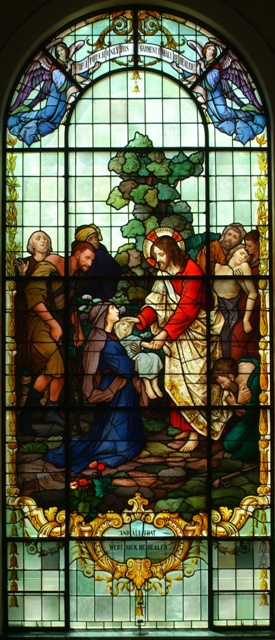
Jesus heals the sick
Jesus performed wondrous acts of healing during his public ministry, as recounted in the Gospels. He did so for two main reasons: for love of his fellow human beings and to show to that he really was the Son of God and had come to do the Father’s will. Thus we should not be surprised to find a window at Saint John’s devoted to his healing miracles. Located along the north wall of the nave, the window brings together, in image and text, several acts of healing. Moreover, the window suggests the dual purpose of Jesus’ cures.
In the center of the window, Jesus tenderly lays a hand on the head of sick little girl as he touches the invalid’s arm with the other. Her mother holds her and with her eyes beseeches Jesus to restore her offspring to life. The child’s limp body, pale skin, and tear-filled eyes warn us that she has not long to live—unless a miracle happens. Jesus’ act of touching the little girl assures us that the she will soon be back to good health. The quote in the cartouche at the bottom of the window confirms this, “And all that were sick he healed.” (Matt. 8: 16) Jesus’ placement in the composition, eye-catching attire, alignment with a nearby tree and act of receiving petitioners make him the focus of the window.
As Jesus attends the dying child, a number of men, either alone or in groups, advance upon him with their own concerns. At the left of the window, a shabbily dressed man on crutches hobbles forward, his face full of hope and anticipation. His belief in the Savior’s powers encourages us to believe as well. We can imagine that in a few moments he will throw aside his crutches and walk away unaided. A distressed man in a turban accompanies the cripple. The lack of any apparent signs of distress prompts imagination. What could his affliction be? A third man, looking extremely pale and somewhat startled, follows. The artist might have rendered this man’s face as pale to suggest disease, demonic possession, or even distance, as objects tend to look paler the farther away they are. Perhaps he represents one of those who journey with the sick and take care of them. Behind Jesus, two men support an unconscious youth. The configuration of these three men and the exposed body of the young man are traditional artistic elements in the depictions of Jesus being taken down form the cross. In this schema Joseph of Arimathea and Nicodemus gently lower the dead body of Christ to the ground in such a way as to show off the wounds on his chest, hands and feet. By casting the ill young man in the guise of the dead Jesus and juxtaposing them, the image is a powerful reminder of Jesus’ great love for humanity and his suffering unto death. It reminds us that, like us, Jesus too suffered. At Jesus’ feet a man humbly kneels and kisses the edge of his cloak, an act described in the quote at the top of the window “If I touch only his garment, I shall be healed.” (Matt. 8: 21) (In the Gospels a woman suffering from an issue of blood voices the phrase.)
The artist chose to depict the arrival of petitioners rather than the cure of them. Looking at the image and reading the accompanying texts, however, we can easily imagine the outcome of the Savior’s acts. Jesus cured believers to show the power of faith and attest that he was indeed the Son of God. For how else could he cure the sick, the lame, and the possessed?